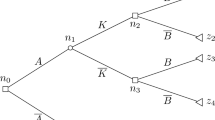Abstract
The study of decision making has traditionally been dominated by axiomatic utility theories. More recently, an alternative approach, which focuses on the micro-mechanisms of the underlying deliberation process, has been shown to account for several “paradoxes” in human choice behavior for which simple utility-based approaches cannot. Decision field theory (DFT) is a cognitive-dynamical model of decision making and preferential choice, built on the fundamental principle that decisions are based on the accumulation of subjective evaluations of choice alternatives until a threshold criterion is met. This article extends the basic DFT framework to the domain of dynamic decision making. DFT-Dynamic is proposed as a new alternative to normative backward induction. Through its attention to the processes underlying planning and deliberation DFT-D provides simple, emergent explanations for violations of choice principles traditionally taken as evidence of irrationality. A recent multi-stage decision making study is used to showcase the model’s efficacy for developing cognitive models of individual strategies.
Similar content being viewed by others
References
Allais M. (1953) Le comportement de l’homme rationnel devant le risque: Critique des postulats et axiomes de l’école Américaine. Econometrica 21: 503–546
Aschenbrenner K. M., Albert D., Schmalhofer F. (1984) Stochastic choice heuristics. Acta Psychologica 56(1–3): 153–166
Ashby F. G. (2000) A stochastic version of general recognition theory. Journal of Mathematical Psychology 44: 310–329
Busemeyer J. R. (1985) Decision making under uncertainty. Journal of Experimental Psycology: Learning, Memory, & Cognition 11: 538–564
Busemeyer J. R., Diederich A. (2010) Cognitive modeling. Sage, New York
Busemeyer J. R., Goldstein D. (1992) Linking together different measures of preference: A dynamic model of matching derived from decision field theory. Organizational Behavior and Human Decision Processes 52: 370–396
Busemeyer J. R., Townsend J. T. (1993) Decision field theory: A dynamic-cognitive approach to decision making in an uncertain environment. Psychological Review 100(3): 432–459
Busemeyer J. R., Weg E., Barkan R., Li X., Ma Z. (2000) Dynamic and consequential consistency of choices between paths of decision trees. Journal of Experimental Psychology: General 129(4): 530–545
Carbone E., Hey J. D. (2001) A test of the principle of optimality. Theory and Decision 50: 263–281
DeGroot M. H. (1970) Optimal statistical decisions. McGraw-Hill, New York
Diederich A. (2003) Decision making under conflict: Decision time as a measure of conflict strength. Psychological Science 10: 353–359
Diederich A., Busemeyer J. R. (2003) Simple matrix methods for analyzing diffusion models of choice probability, choice response time, and simple response time. Journal of Mathematical Psychology 47: 304–322
Fehr E., Rangel A. (2011) Neuroeconomic foundations of economic choice—recent advance. The Journal of Economic Perspectives 25(4): 3–30
Hey J. D., Knoll J. A. (2011) Strategies in dynamic decision making—an experimental investigation of the rationality of decision behavior. Journal of Economic Psychology 32: 399–409
Hotaling J. M., Busemeyer J. R., Li J. (2010) Theoretical developments in decision field theory: Comment on Tsetsos, Chater, & Usher. Psychological Review 117(4): 1294–1298
Johnson J. G., Busemeyer J. R. (2001) Multiple-stage decision-making: The effect of planning horizon length on dynamic consistency. Theory and Decision 51: 217–246
Johnson J. G., Busemeyer J. R. (2005) A dynamic, stochastic, computatonal model of preference reversal phenomena. Psychological Review 112(4): 841–861
Kahneman D., Tversky A. (1979) Prospect theory: An analysis of decision making under risk. Econometrica 47: 263–292
Laming D. R. (1968) Information theory of choice-reaction times. Academic Press, New York
Link S. W., Heath R. (1975) A sequential theory of psychological discrimination. Psychometrika 40: 77–111
Marr D. (1982) Vision: A computational approach. Freeman, San Francisco
Nosofsky R. M., Palmeri T. J. (1997) Exemplar-based accounts of relations between classification, recognition, and typicality. Psychological Review 104(2): 266–300
Payne J. W., Bettman J. R., Johnson E. J. (1993) The adaptive decision maker. Cambridge University Press, New York
Ratcliff R. (1978) A theory of memory retrieval. Psychological Review 85(2): 59–108
Roe R. M., Busemeyer J. R., Townsend J. T. (2001) Multialternative decision field theory: A dynamic connectionist model of decision making. Psychological Review 108(2): 370–392
Smith P. L. (1995) Psychophysically principled models of visual simple reaction time. Psychological Review 102(3): 567–593
Svenson O., Edland A. (1987) Changes of preference under time pressure: Choices and judgements. Scandanavian Journal of Psychology 28: 322–330
Usher M., McClelland J. L. (2001) The time course of perceptual choice: The leaky, competing accumulator model. Psychological Review 108(3): 550–592
Vickers D. (1979) Decision processes in visual perception. Academic Press, New York
Wallsten T. S., Barton C. (1982) Processing probabilistic multidimensional information for decisions. Journal of Experimental Psycology: Learning, Memory, & Cognition 8: 361–384
Author information
Authors and Affiliations
Corresponding author
Rights and permissions
About this article
Cite this article
Hotaling, J.M., Busemeyer, J.R. DFT-D: a cognitive-dynamical model of dynamic decision making. Synthese 189 (Suppl 1), 67–80 (2012). https://doi.org/10.1007/s11229-012-0157-0
Received:
Accepted:
Published:
Issue Date:
DOI: https://doi.org/10.1007/s11229-012-0157-0




